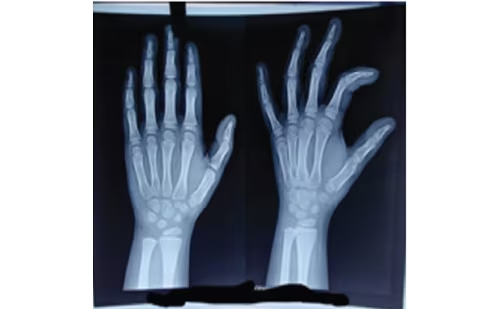The isolation of human prolactin (PRL) in the 1970s and the recognition that hyperprolactinaemia resulted in a syndrome of amenorrhoea or galactorrhoea was a significant advance. Subsequently, it has been shown that hyperprolactinaemia may be the cause of secondary amenorrhoea in up to one-third of young women. PRL is a 199-amino-acid polypeptide with a molecular weight of 23 kilo Daltons (kDa) that is similar in structure to growth hormone.
The isolation of human prolactin (PRL) in the 1970s and the recognition that hyperprolactinaemia resulted in a syndrome of amenorrhoea or galactorrhoea was a significant advance. Subsequently, it has been shown that hyperprolactinaemia may be the cause of secondary amenorrhoea in up to one-third of young women. PRL is a 199-amino-acid polypeptide with a molecular weight of 23 kilo Daltons (kDa) that is similar in structure to growth hormone. The main target tissue of PRL has traditionally been thought to be the breast, but PRL receptors have been demonstrated in several tissues, including liver, ovary, testis and prostate. The function of PRL at these sites remains poorly understood.
The predominant hypothalamic factor regulating PRL secretion is dopamine, which inhibits secretion from pituitary lactotrophs. Thyrotropinre-leasing hormone (TRH) and vasoactive intestinal peptide (VIP) are stimulatory to PRL secretion, and a further stimulatory factor known as PRL-releasing peptide has also been discovered. However, the physiological importance of these factors is still unclear.
Physiological Elevation of PRL
The most common cause of physiological hyperprolactinaemia is pregnancy, so this must be excluded in all women who present with hyperprolactinaemic amenorrhoea. PRL is stimulated by suckling and remains elevated for a variable period of time during lactation. The extent of the bioactivity of PRL is believed to be important in determining the duration of lactational amenorrhoea. Neural links between the breast/chest wall and hypothalamus are thought to be an important mechanism via which PRL is increased. This mechanism is responsible for hyperprolactinaemia arising from breast stimulation and chest wall and cervical cord lesions. It has been shown that the extent of the PRL rise after breast surgery is of prognostic significance for women with breast cancer. PRL may also be elevated after seizures. Finally, elevations in PRL are part of the human sexual response, with an acute stimulus observed in both sexes following orgasm. It has been suggested that this response contributes to the regulation of sexual arousal and reproductive function.
Pathological Hyperprolactinaemia
The causes of pathological hyperprolactinaemia are listed in Table 1. While PRL elevation of virtually any cause can be inhibited by dopamine agonists, it is important to make a more specific diagnosis to optimise management. Clinically, female patients typically present with one or more of secondary amenorrhoea or oligomenorrhoea, galactorrhoea or infertility. Males, on the other hand, often present with symptoms of mass effect, including headache and visual loss, although most have symptoms and signs of secondary hypogonadism on specific enquiry. Bone loss leading to osteoporosis may be present; this is a feature of the resulting hypogonadism rather than the hyperprolactinaemia per se.
PRL-secreting Pituitary Adenomas
Prolactinomas are the most common form of pituitary adenoma, and they make up approximately one-third of all pituitary neoplasms. Pituitary tumours secreting PRL in addition to other hormones are also well described; growth hormone (GH)-secreting tumours may co-secrete PRL, while the combination of adrenocorticotropic hormone (ACTH) and PRL hypersecretion in Cushing’s disease is also reported. Prolactinomas, similarly to other pituitary adenomas, are defined in relation to their size on presentation:
- Those that are smaller than 10mm constitute a microadenoma.
- Those that are 10mm or larger constitute a macroadenoma.
The biological behaviour of macroprolactinomas may be inherently different. This is particularly evident in males, where a greater proportion of prolactinomas present as macroadenomas, compared with females, where the majority are microadenomas. Males have larger and more invasive tumours, which are more frequently resistant to bromocriptine.
Generally, macroprolactinomas are associated with a more than 10-fold increase in PRL levels to more than approximately 5,000mIU/litre (200μg/litre). A modest elevation of PRL in the order of 1,000–2,000mIU/litre in the presence of a macroadenoma is usually due to a non-functioning pituitary adenoma obstructing the flow of dopamine through the hypothalamic–hypophyseal portal circulation to the normal pituitary lactotrophs. Making this distinction is important, as the majority of prolactinomas will respond to medical therapy with dopamine agonists, while the treatment of choice for a non-functioning pituitary adenoma is transsphenoidal surgery. In the case of a cystic lesion, the differential diagnosis must widen to include a craniopharyngioma or Rathke’s cleft cyst. Sometimes, a definitive diagnosis cannot be made pre-operatively, and if there is compromise to the visual pathways, pituitary surgery may be required. Routine immunohistochemistry on the pituitary tumour surgical specimen can guide the future management of such patients. The presence of positive PRL staining may indicate a dopamineagonist- responsive tumour.
Non-secretory Hypothalamic–Pituitary Lesions
Among the variety of non-secretory sellar and hypothalamic lesions that obstruct or prevent the flow of dopamine to the lactotrophs and may result in significant hyperprolactinaemia, a non-functioning pituitary adenoma is the most common. However, other neoplastic and inflammatory lesions of the hypothalamus and pituitary and the empty sella syndrome can also cause this, as outlined in Table 1.
Drug-induced Hyperprolactinaemia
Significant elevations in PRL may result from a number of commonly used medications (see Table 2). As in patients with prolactinoma, this can lead to clinically relevant dysfunction of the reproductive axis in both sexes. In clinical practice, the most common drug classes that result in hyperprolactinaemia are the antipsychotics, antiemetics and opiates. The diagnosis of drug-induced hyperprolactinaemia requires that structural pituitary lesions are excluded. Where the drug can be ceased or withheld, the demonstration of a normal PRL is usually sufficient to make the diagnosis. There are, however, many patients for whom this is not possible due to their psychiatric condition or chronic pain syndrome. Under such circumstances, performing a magnetic resonance imaging (MRI) scan is advisable.
Other Causes of Pathological Hyperprolactinaemia
Hyperprolactinaemia has been noted in patients with renal failure and cirrhosis. Primary hypothyroidism can also lead to high PRL levels, mainly due to the stimulatory effect of TRH on PRL secretion. Adrenal insufficiency can be associated with modest hyperprolactinaemia, possibly due to the low cortisol level. Women with polycystic ovary syndrome (PCOS) may have mild hyperprolactinaemia in the absence of a pituitary lesion. There remains a small group of patients where no underlying abnormality is discovered; their form of hyperprolactinaemia is termed ‘idiopathic’. Follow-up studies of such patients have reassured clinicians that a later discovery of a pituitary adenoma is uncommon, occurring in fewer than 10% of cases.
Macroprolactin
In recent years, it has become more widely recognised that some cases of apparent hyperprolactinaemia are not associated with any clinical features despite considerably elevated PRL levels. PRL may form immune complexes with immunoglobulin G (IgG), resulting in a biologically inactive form known as macro-prolactin. Macroprolactin may be responsible for elevated PRL in 10% of cases in unselected series. The vast majority of patients do not have any reproductive dysfunction, and pituitary adenomas are present in only approximately 5%. When the macroprolactin is precipitated using polyethylene glycol (PEG), the residual PRL level is normal in most subjects. Different immunoassays may cross-react to a greater or lesser extent with macroprolactin and, in the laboratory, a significant reduction in PRL following PEG precipitation is a useful screen for its presence.
Investigation of Hyperprolactinaemia
A flow chart for the investigation of hyperprolactinaemia is presented in Figure 1. The basic principles involve excluding physiological and non-neoplastic causes, pituitary neuroimaging and biochemical assessment of pituitary function. In patients where the hyperprolactinaemia is borderline, measuring it three times at 30-minute intervals using an in-dwelling cannula will exclude any temporary elevation due to stress. Sometimes, using two-site immunoassays, there is marked underestimation of the PRL level due to saturation of both antibodies, the so-called ‘hook effect’. Performing the assay using a 1:100 dilution will generally disclose the true PRL level. Where an individual harbours a large sellar mass, it is mandatory to check the remaining anterior pituitary function, particularly to exclude secondary hypothyroidism and hypoadrenalism. It is recommended that insulin-like growth factor 1 (IGF-1) always be measured where a prolactinoma is discovered, as sub-clinical growth hormone (GH) excess may co-exist. MRI is the radiological investigation of choice. The increased resolution of modern MRI scanners has improved the sensitivity for detecting microadenomas, and the use of gadolinium contrast and dynamic sequences has further enhanced detection. Thus, the number of genuine idiopathic hyperprolactinaemia cases is probably much smaller now than when where CT scanning was relied upon for diagnosis. Visual field assessment may be reserved for patients where there is MRI evidence of impingement on the optic apparatus. ■
This article is continued, with references, in the Reference Section on the website supporting this business briefing (www.touchbriefings.com).







